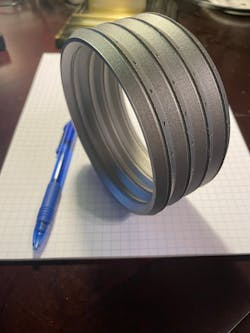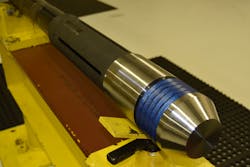How Design for Excellence (DfX) Intersects with Rapid Prototyping
Additive manufacturing is gaining a reputation for its effective use of design technology to re-design a product in record time. Design for Additive Manufacturing (DfAM) differs considerably from traditional manufacturing—both in prototyping and production methods—giving it a unique angle on Design for Excellence (DfX).
DfX refers to a set of principles intended to analyze the way a product and process has been designed with the intention of optimizing the design of a product. These principles force design and engineering teams to risk in the development of the product by considering important manufacturability factors and making changes to the design before a component reaches the shop floor.
DfX has a solid footing in traditional manufacturing processes, but is equally relevant to additive manufacturing. Machine Design asked Eric Utley, applications engineer, Protolabs, North Carolina, to consider how DfX principles support 3D printing.
Machine Design: If you were to apply the concept of Design for Excellence (DfX) to Design for Additive Manufacturing (DfAM), how would you relate it to improving the design, testing phase and reducing part counts?
Eric Utley: If the part is truly being designed for additive manufacturing, then some thought has to be given to not just how well or efficiently the part prints but also the secondary processes that follow. At a minimum, virtually any additive process will require either scaffold supports to be removed or excess material to be blasted off. Particularly if the expectation is that the part is to be printed in elevated volumes, then it can be very beneficial to start considering things like optimizing to avoid supports, adding holes to inaccessible areas to make cleaning easier, or adding fixture points to the part to hold it for secondary processes such as painting or electroplating.
READ MORE: DfX: How Design for Excellence Guides Product Development
MD: What are the defining characteristics and methods that ensure a sound DfX approach has been applied to the development of a product in a digital manufacturing process?
EU: With digital manufacturing in mind, it can be important to realize that any manufactured product has a lifecycle. It may make sense to transition between or even toggle back and forth between different manufacturing methods as demand changes or as the product evolves to match the demands of the customer. A part may start as additive in early stages when volumes are low, and scale up to injection molding at higher quantities. You may have periods where the part is both printed and molded because you are trying a variation on the design with new customers.
Digital manufacturing gives additional flexibility in quickly iterating on the design and improving it and not having a stagnant product that competition can definitively respond to. We see a larger trend that product cycles are shortening and product lines can undergo design changes more frequently. A good DfX approach would be to ensure that there is both a well-designed additive version of the part and a well-designed conventional version. Even better is if these two versions are the same geometry.
MD: From your experience in additive manufacturing, which has the biggest economic return: DFM (how to improve the manufacturing of parts and components) or DFA (how to improve the processes of putting together parts and components into assemblies and then completed products)?
EU: This depends greatly on the product. Typically, for high quantities of small parts, it is best to focus on how to eliminate labor, such as reducing or even eliminating the need for support structures or excessive cleaning operations. For larger parts it can be valuable to spend time on reducing unneeded material because in additive the [value of] material is not just raw material cost but also print time. Designing parts to be built additively and reducing assemblies is very beneficial to highly regulated industries.
READ MORE: A History of Design for Manufacturing and Assembly
MD: What key features are companies adding to their DfAM software?
EU: Our DfAM tool for our website advises on features too thin to form and gaps too narrow that will seal shut during the print. From our experience, these were the top issues we found when communicating with customers. Other things of interest are warp analysis and quick visualization of where supports will be required on the part and the impact build direction has on the surface finish. More sophisticated tools look at the print layer-by-layer and look at risk of material shrinkage, which is a major design hurdle for printing in metal via DMLS (direct metal laser sintering).
MD: Please tell us about Protolabs’ DfAM capabilities.
EU: Our current capabilities will give instant feedback on an uploaded 3D CAD and will advise whether a part is too large for the selected 3D printing technology, as well as give a 3D viewer of the part and will highlight any areas too thin to form and any gaps that are too small and will likely seal shut during the printing process. We plan on expanding the capabilities in the future.
MD: How does DfAM support product developers and engineers to optimize designs and support their DfX goals? Can you provide an example?
EU: The Downhole Emerging Tech project is a good example of DfAM getting a viable product up and running quickly. [Background: The U.S. Department of Energy (DOE) put out a call for engineers and scientists to address challenges associated with operating sensitive equipment in harsh geothermal environments. Houston-based startup Downhole Emerging Technologies (DET) responded to the challenge and turned to ProtoLabs for design assistance in developing a packer or plug system.] In this case the customer uploaded an early concept that would not print cleanly. But after some quick advisement they were able to modify the design to require nearly no support structure and have as little labor as possible.
The internal structure of the part made it non-conducive to being made more conventionally. For Protolabs, our automated tool on the website provided some initial, instant feedback and, in the case of this part, it came from discussions with our applications engineers on how to design the part to be self-supporting. We provide a lot of easily accessible content on how to design for DMLS (direct metal laser sintering), the process used in making DET’s component.
MD: How does DfAM support scalability?
EU: Scalability is supported when a part is well designed for additive, or if there is a version of the part designed for additive that can give additional flexibility to service both niche markets and supply chain disruptions. For example, there may be a customer who wants a custom version of the product but the quantities do not justify cutting a new molding tool. Also, the 3D printed variant of the product can be used as the part is sunsetted and it is no longer viable to keep molding it. This is becoming a more popular approach in the automotive and aerospace industry to support replacement parts for products that are no longer in production.
Finally, being able to quickly shift production to additive can be crucial in supply chain disruption situations. With COVID, supply chain gridlock and the war in Ukraine, we saw lots of products temporarily shift to 3D printing as injection molding material supply dried up or production capacities had to rapidly shift to mission-critical products.
MD: What industry seems to be the best at using DfAM? What’s driving the success?
EU: Aerospace and medical industries are leading the charge. Aerospace has the most to gain from DfAM because the focus is on both reducing weight and reducing assemblies. Particularly when putting payloads into space does weight come at an extreme premium. Aerospace will happily pay for a high value additive part that is substantially lighter than a conventionally manufactured part. Both aerospace and medical are highly regulated industries and reduction of assembly is a big focus.
While there can be significant labor reduction with reduction of assembly, for the aerospace and medical industries there is a significant paper trail behind any part, and reducing the number of parts in an assembly in an airplane or a surgical robot significantly reduces the logistical overhead. Eliminating a single part from an assembly may save a company from having to audit and manage an entire supplier.
About the Author

Rehana Begg
Editor-in-Chief, Machine Design
As Machine Design’s content lead, Rehana Begg is tasked with elevating the voice of the design and multi-disciplinary engineer in the face of digital transformation and engineering innovation. Begg has more than 24 years of editorial experience and has spent the past decade in the trenches of industrial manufacturing, focusing on new technologies, manufacturing innovation and business. Her B2B career has taken her from corporate boardrooms to plant floors and underground mining stopes, covering everything from automation & IIoT, robotics, mechanical design and additive manufacturing to plant operations, maintenance, reliability and continuous improvement. Begg holds an MBA, a Master of Journalism degree, and a BA (Hons.) in Political Science. She is committed to lifelong learning and feeds her passion for innovation in publishing, transparent science and clear communication by attending relevant conferences and seminars/workshops.
Follow Rehana Begg via the following social media handles:
X: @rehanabegg
LinkedIn: @rehanabegg and @MachineDesign



